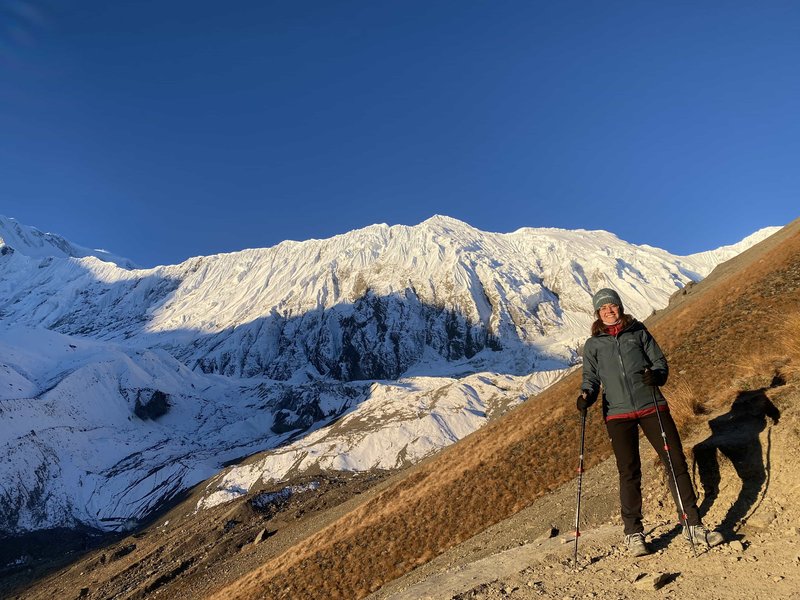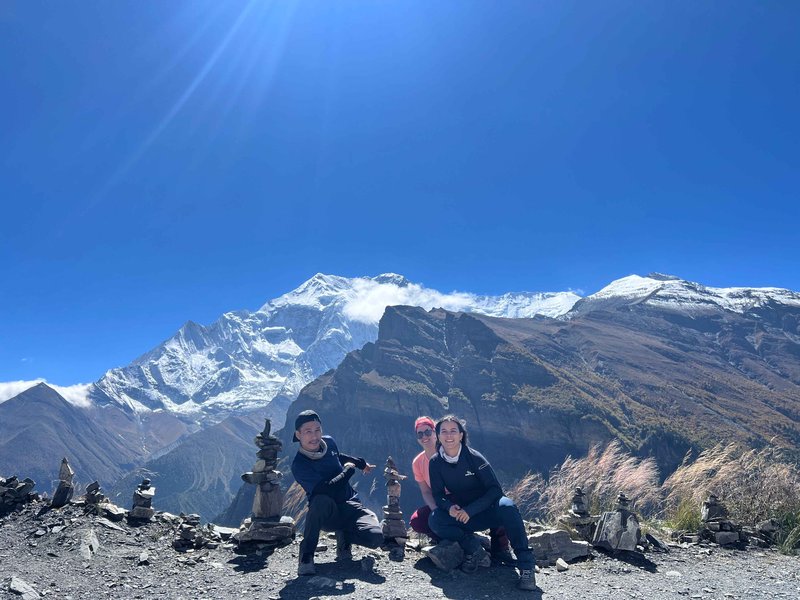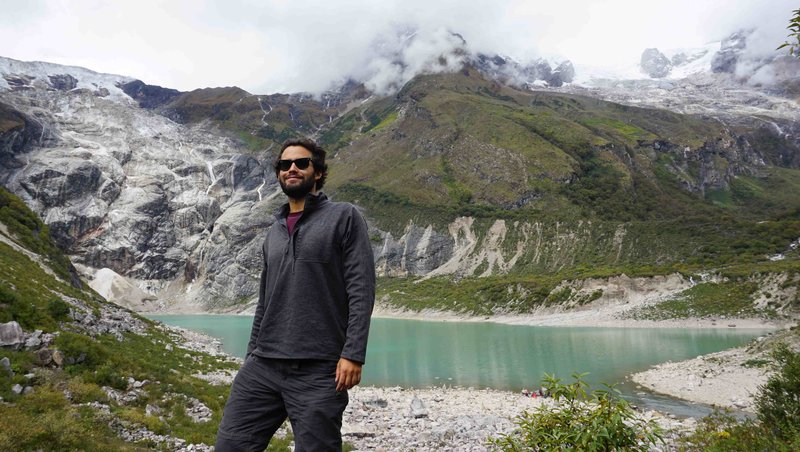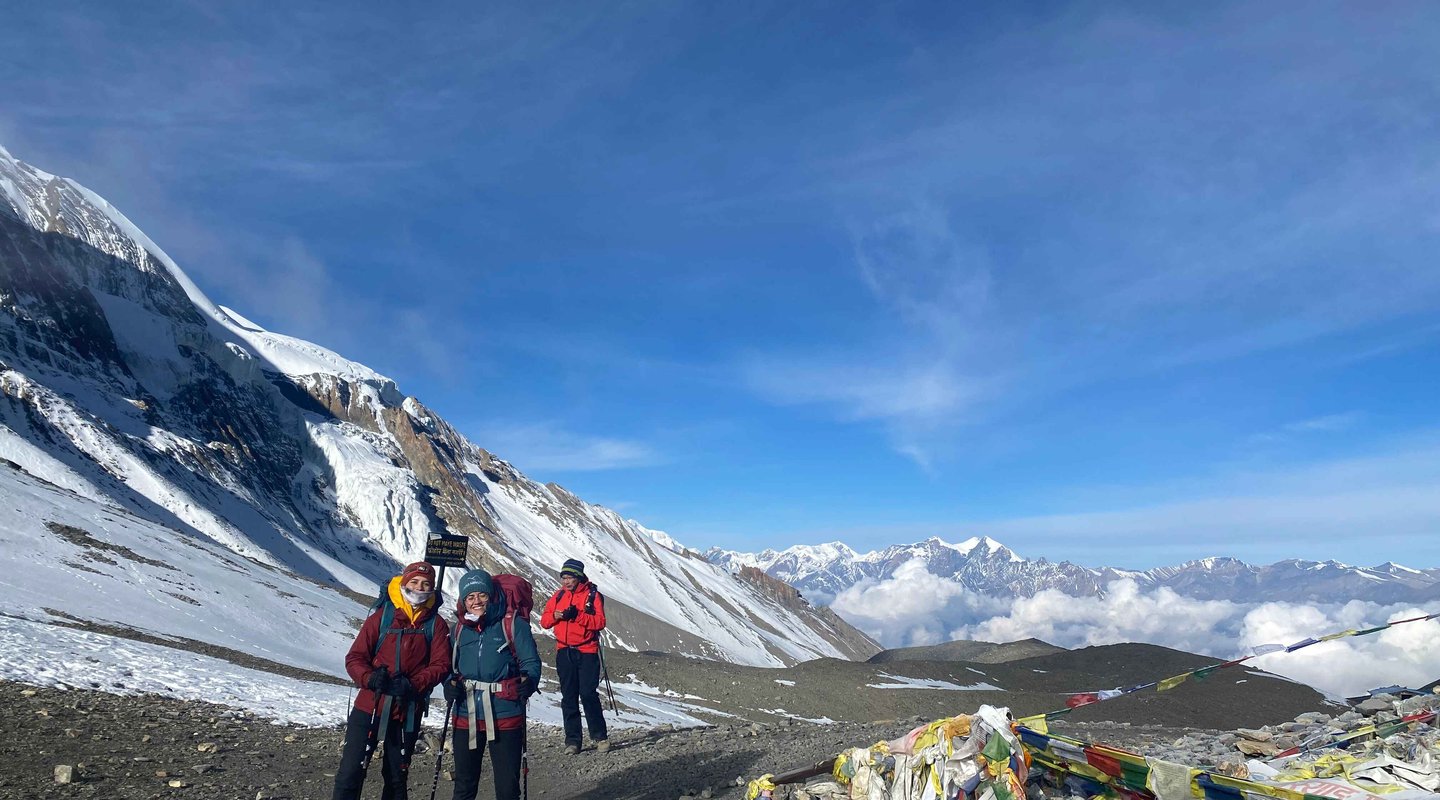If you want to embark on the Annapurna Circuit Trek, you need to know the weather conditions, patterns, and the trail conditions of different seasons to make the most of your journey. The Annapurna Circuit Trek is on the bucket list of many adventure seekers.
Although you can embark on the Annapurna Circuit Trek in any of the seasons, choosing the best season will make your journey a rewarding experience for you.
Through this article, we will be guiding you with Annapurna Circuit peak season and overall conditions of each season so that you can decide your best time to trek Annapurna Circuit according to your preferences.
Understanding Annapurna Circuit Weather: Key Climates & Factors
The Three Climates of the Circuit (Subtropical, Temperate, Alpine)
The Annapurna Circuit temperatures are diverse with varying altitudes. The Annapurna Circuit can be divided into 3 distinct zones with their own distinct climates, such as subtropical , temperate, and alpine.
Especially during Annapurna Circuit monsoon trekking, you can find subtropical climates, such as high humidity, warm temperatures, and ample rainfall, in the lower regions (600 to 1500 meters) like Besisahar and Bhulbhule. You will find tropical vegetation, bamboo, and dense forests of rhododendron, a zone filled with greenery.
As you ascend to the temperate climate zone (1500 to 3300 metres), you will find a dry area with moderate temperatures, especially during Annapurna Circuit autumn trekking. You can see the transition in the landscape with the mixed forests, which are dominant with the cooler temperatures at night.
As you ascend higher, especially at altitudes above 3300 meters or at Thorong La Pass (5,416 m/17,769 ft), you will find low temperatures, and the landscape consists of grasses and hardy shrubs with a scarcity of vegetation. You'll find rapid changes in weather, especially the possibility of severe winds and snow, making the route rugged and slippery, which will be challenging and exhausting for you.
Altitude's Impact on Weather
Annapurna Circuit’s weather is mixed with the variations in precipitation, wind patterns, and temperature mainly influenced by altitude. You can find 30°C (86°F) as the average temperature in the lower elevations of 1,000 meters during the daytime, but it will drop at nighttime.
As you ascend higher to the altitude ranging from 1,500 to 3,000 meters, you will find the weather slightly unpredictable and cool temperatures of 20°C (68°F) during the daytime. This region has a higher probability of getting rain in the monsoon season, making the trails slippery with the increased clouds.
While in the region above 3,000 meters, there is reduced oxygen, with temperatures around 10°C (50°F) during the daytime and below freezing at night. The strong winds come without warning, which will make your journey more challenging, including the snowfall in winter. Therefore, you need to understand the varied weather conditions at different altitudes and prepare yourself with the plan of a successful Annapurna Circuit Trek.
We have also covered a detailed piece of information on the packing checklists for the Annapurna Circuit trek.
Annapurna Circuit Trekking Seasons: Pros & Cons

Autumn (September to November): The Golden Window
Autumn is the best time to trek the Annapurna Circuit. Annapurna Circuit autumn trekking, from September to November, will offer you the best weather and trail conditions, making your journey more comfortable and enjoyable.
Weather Conditions (Temperature, Precipitation, Visibility)
Annapurna Circuit temperatures at daytime in lower regions
10°C to 20°C (50°F to 68°F)
Annapurna Circuit temperatures at daytime in higher regions
-5°C to 5°C (32°F to 23°F)
Precipitation levels 50 to 100 mm of rainfall
October is the driest month, minimizing the risk of landslides and slippery and muddy paths.
Visibility is excellent during Annapurna Circuit autumn trekking. You will find the clearest skies in October and early November, allowing you the majestic view of the snow-capped peaks of Mt. Annapurna and Mt. Dhaulagiri.
Advantages
Annapurna Circuit autumn trekking will offer you remarkable weather conditions. This is the Annapurna Circuit's peak season, so regardless of you being a beginner or a seasoned trekker, autumn will be the best time to trek the Annapurna Circuit for you.
Stable weather: The weather is stable, offering you the clearest skies, allowing you to see the stunning views of Mt. Annapurna and Mt. Dhaulagiri. You will find sunny and dry weather with fresh air.
Best trail conditions: There is minimum rainfall, which will make the trails remain in the best condition, minimizing the risk of you slipping due to muddy and slippery trails and, more importantly, reducing the risk of landslides, making your journey safer.
Comfortable temperatures: You will find the average temperatures ranging from 10°C to 18°C at lower levels and a bit cooler at higher elevations, but it is not too cold.
Festivals: You will get an opportunity to immerse yourself in the culture of the locals during the biggest festivals of Nepal fall during this Annapurna Circuit peak season: Dashain and Tihar. So if you are a cultural enthusiast, autumn trekking on the Annapurna Circuit will be the best time to trek the Annapurna Circuit for you to get the cultural insights of the Himalayas of Nepal.
Considerations
Overcrowded Trails: Autumn being the Annapurna Circuit peak season, the trails will be crowded, which might make you feel annoyed and hamper your pace on the planned track.
Higher Prices: You can also consider this season according to your budget because the prices in this season will be higher than the other seasons.
Accommodation Issue: You may face a potentially tough time finding accommodation or good accommodation with good facilities, as you might be sleeping in the kitchen or dining area because of overcrowding in the teahouses.
Spring (March to May): Blooms and Mildness
Spring is taken as one of the best times to trek the Annapurna Circuit. You will see clear skies and experience better views during Annapurna Circuit spring trekking. Spring is all about greenery and the season of blooming rhododendrons.
Weather Conditions
Annapurna Circuit temperature at daytime in lower regions
10°C to 15°C (50°F to 59°F)
Annapurna Circuit temperature at daytime in higher regions
0°C (32°F)
Precipitation levels 100 to 200 mm of rainfall
The visibility is excellent in spring, especially in April, as the skies are clear and there is less air pollution. Also, there is a gradual increase in temperatures contributing to the blooming of diverse flora in the region.
Advantages
Moderate Temperature: There is a moderate temperature ranging from 10 to 20°C at lower altitudes and 0°C at higher altitudes. There are better views because of the clear skies with the majestic view of the stunning snow-capped peaks of Mount Annapurna and Mount Dhaulagiri. There will be longer days, so you will get more daylight hours to trek the Annapurna Circuit.
Blooming Rhododendrons: Spring is the Annapurna Circuit rhododendron season that will offer you the diverse flora and fauna contributing to the scenic beauty of the Annapurna Circuit. You will see rhododendrons blooming along the trails in abundance. Along with the rhododendrons, other flowers such as magnolias and orchids can be seen, and the greenery surrounds the trails.
Festivals: Nepalese New Year falls in April, which will give you insight into how it is celebrated by Nepalese, especially by the locals in the Himalayas.Bisket Jatra, a cultural festival celebrated in our country, these celebrations will also enhance your Annapurna Circuit trekking with the richness of Nepalese culture.
Considerations
Haze: You may find haze during your Annapurna Circuit spring trekking at times, which might obscure your visibility, bringing some difficulty in the navigation of trails.
Overcrowding: Annapurna Circuit crowds by season. Spring usually has less trekkers than autumn; you can still find yourself on congested trails. If you are someone who loves a peaceful or quiet journey, then you should consider Annapurna Circuit Spring trekking.
Accommodation Issue: Spring being one of the ideal times for Annapurna Circuit trekking, the trekkers are found in large numbers. So, due to such a high number of trekkers, you may find difficulty in finding the houses to sleep in.
Winter (December to February): For the Brave & Experienced
Annapurna Circuit winter trekking is for the brave ones who are ready to test their strength because it is challenging because of the freezing temperatures, although you might get clear skies and some benefits with the prices.
Weather Conditions (Extreme Cold, Snowfall)
Annapurna Circuit temperatures at daytime in lower regions
10°C to 15°C (50°F to 59°F)
Annapurna Circuit temperatures at daytime in higher regions
-20°C to -5°C (4°F to 23°F)
Precipitation levels 50 to 80 mm of rainfall
The weather in winter is extremely cold, like chilling temperatures, and there is heavy snowfall accumulating at the trails, making the navigation a hassle for you.
Advantages
Tranquility: Annapurna Circuit Winter trekking will offer you the feeling of tranquility, making it the best time to trek the Annapurna Circuit for those who want peace and quiet, giving them ample time to fully take in the feel of the journey.
Snowscapes: Annapurna Circuit Winter trekking offers you the scenic beauty of the snowscapes, as there will be heavy snowfall and the trails will be full of ice and snow.
Fewer Crowds: Annapurna Circuit crowds in the winter get fewer trekkers than other seasons, so you will find fewer people along the trails, giving you the benefit of choosing good accommodation with good facilities.
Lower Prices: Winter being the off-season, you will find your accommodation at the tea houses and services relatively at lower prices, which might help you with your expenses and budget.
Considerations
Pass Closures: Because of the freezing temperatures, the highest point of the trek, Thorong La Pass (5,416 m/17,769 ft), and other high passes may get closed.
Limited Services: Winter being the off-season, you might get limited services, giving you limited options with the accommodation and food choices.
High Risk: Annapurna Circuit Winter trekking is actually very risky, especially for beginners. So, winter may be an ideal time only for the experienced ones rather than for those who are stepping on these long walking durations with the extreme weather conditions for the very first time in life. Although you should always prioritize your safety regardless of the season you embark on.

Summer/Monsoon (June to August): The Green & Challenging Season
Annapurna Circuit Summer trekking is the least recommended time among the list of the best times to trek the Annapurna Circuit. Because of the heavy rainfall leading to the risk of landslides and you falling due to the wet, muddy, and slippery trails. This is not a favorable season, although trekking is possible at this time.
Weather Conditions
Annapurna Circuit temperature at daytime in lower regions
15°C to 30°C (59°F to 86°F)
Annapurna Circuit temperature at daytime in higher regions
0°C to 12°C (32°F to 54°F)
Precipitation levels 400 to 600 mm of rainfall
The humidity level exceeds up to 80%, making the air feel heavier, which may also make your gear and equipment get moldy and damp, especially at lower elevations, whereas the heavy rainfall brings hurdles in your path.
Advantages
Lush Greenery: Because of the rainfall, you will find green forests, terraced fields, and lush valleys along the trails, which might offer you the feeling of being close to real nature.
Empty Trails: Being the off-season, Annapurna Circuit summer trekking actually does not get many trekkers. So if you want a solitary experience or a quiet journey, then summer will be an ideal time for you.
Discounts: You can get discounts on the trekking services and accommodation at tea houses, as Annapurna Circuit summer trekking is the least favored among the list of best times to trek the Annapurna Circuit.
Considerations
Landslides and flooding: Due to the constant heavy rain, you are more prone to landslides and being swept away by the flood. The trails will also be at their poorest conditions, being muddy, wet, and slippery, causing you to fall down and get severely injured.
Leeches: The atmosphere becomes highly moist because of the heavy rain. So, there will be more leeches and insects coming out on the trails, creating a hassle in your walking pace.
Poor Visibility: The visibility is so poor because of the heavy clouds and rain that the views of the serene beauty of the Annapurna Circuit and the snow-capped mountains will be fully obstructed.
Month-by-Month Annapurna Circuit Weather & Conditions
You can know the diversity in Annapurna Circuit weather by month through the following description:
January & February
January and February, being the peak seasons of winter, possess the coldest temperatures, which can be as low as -10°C. There will be heavy snowfall, making the trails challenging to the extreme level because of ice and snow everywhere, and especially crossing Thorong La Pass (5,416 m/17,769 ft) is difficult. Although winter is the off-season, there will be fewer trekkers, giving a good time to those who seek a peaceful and solitary trekking experience.
March & April
Spring will start during these seasons. March and April are the vibrant and blooming seasons called the Annapurna Circuit rhododendron seasons. The moderate day temperatures, ranging from 10°C to 20°C (50°F to 68°F), with the clear skies and blooming rhododendrons, the serene natural beauty of the snow-capped peaks and greenery around, and the average precipitation level ranging from 30 to 60 mm, make these months one of the best times to trek the Annapurna Circuit for both beginners and seasoned trekkers, although the trails can be busier at this time.
May & June
The anticipation of monsoon or rain begins at this time. By late May you will find mild showers of rain and gradually intensifying rain by June. Annapurna Circuit weather in the months of May and June is warm and sunny, with day temperatures range from 20°C to 30°C (68°F to 86°F) at lower elevations and 10°C to 15°C (50°F to 59°F) at higher elevations on average. The sunny days will typically give you clear visibility even in the higher altitudes. The weather becomes unpredictable during these months, and the trails will be muddy even with the mild showers of rain. Although you can enjoy the scenery of the lush forests and vibrant wildlife due to the early rains.

July & August
July and August are the peak monsoon months. So, there will be heavy rainfall on average, ranging from 400 to 600 mm, making your navigation of the route difficult also because of the heavy clouds and fog. The trails will be difficult because of the heavy rainfall making the trails muddy, slippery, and wet, eventually leading to an increased risk of landslides and you getting severely injured, although the trails will not be congested at this time. You need to be prepared with the right gear and waterproof clothes to navigate the trails safely. To know what you should be packing to take for Annapurna Circuit trekking, you can also check out our article interlink
September & October
September and October are found to be rated as the Annapurna Circuit's peak seasons. The days become mild in warmth, and the monsoon clouds begin to fade, giving you the optimal visibility for witnessing the breathtaking views of the snow-capped mountains like the Annapurna Range. Being the post-monsoon months, you will get to experience minimal rainfall and moderate temperatures, on average ranging from 15°C to 25°C during the day and 5°C at night. The trails are at their best conditions, and coinciding with the festive seasons of Dashain and Tihar, you will get the opportunity to immerse yourself in the rich culture of the locals of Nepal in the Himalayas.
November & December
November and December will mark the transition from the beginning of winter to the end of autumn. The temperatures will begin to drop to chilling temperatures ranging from 10°C to 15°C at lower elevations and -5°C where you can see the first dusting of snow by late November. The snow will accumulate at the trails, and icy paths will hamper your pace of the trek, along with the extreme cold temperatures and thinner oxygen levels causing you severe altitude sickness. It can become even more dangerous at Thorong La Pass (5,416 m/17,769 ft) That too if you are doing a solo Annapurna Circuit Trek in such temperatures, as the trails do not get trekkers in large numbers during these months.
Choosing Your Best Time: Tailoring to Your Preferences
While planning the Annapurna Circuit Trek, you can consider various factors by tailoring your time to your personal preferences to decide the best time to trek the Annapurna Circuit Trek.
For weather conditions, you can choose autumn (September to November) for the moderate temperatures and stable weather conditions with minimal rainfall.
For photography, you can choose spring (March to May) for the best views and optimal visibility. The landscapes are stunning with the rhododendrons blooming around the lush green valleys and terraced fields, along with the diverse vibrant flora and fauna.
For cultural experiences, you can choose autumn (September to November) as the biggest festivals, Dashain and Tihar, fall during this season, giving you an enriching experience with the unique culture of the Himalayas.
For solitude: Going during off-peak seasons such as summer (June to August) and winter (December to February) may suit your preference of wanting a peaceful and solitary experience, as the trails do not have bustling crowds during these seasons, although you will have to face harsh weather conditions.
Please feel free to contact us at [email protected] or
WhatsApp us at +9779801127073.
annapurna-circuit-trek-14-days-himalayan-hero-adventure











